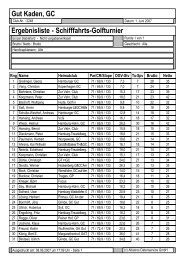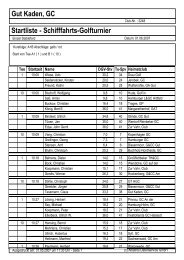Create successful ePaper yourself
Turn your PDF publications into a flip-book with our unique Google optimized e-Paper software.
“Vogesen” seized after the First World War as USS “Quincy” in an American port.<br />
what agency commission he would grant, he replied: “We pay $ 500 for full<br />
cargoes, $ 250 for part cargoes”, which, when you take the devaluation of the<br />
Mark into consideration, was an absolutely astronomical amount of money<br />
at the time. A shed from Hapag was rented through our brokers and a large<br />
poster was affixed to it with the name Pacat Steamship Corporation.<br />
Mr Ainsworth was a typical American business man who did<br />
not mince his words and always knew how to sort himself out. So when the<br />
railway workers went on strike, without further ado, he bought himself a car<br />
so he could travel to Copenhagen. When he did not receive a prompt reply to<br />
the various cables he had sent to his partners in New York, he ordered me to<br />
send a clearly worded telegram to New York which started as follows: “Why<br />
in the hell don‘t you answer my cables you are making a damned fool of me”<br />
and so forth. Normally I had to pick him up from his hotel around midday. He<br />
received me in his dressing gown and made his business visits around 1 p.m.,<br />
when the majority of owners were going to lunch or were hanging around the<br />
stock exchange. The Pacat Steamship Corporation's expeditions still continued<br />
until around 1922; then business slowly began to stagnate because the<br />
corporation ran into financial difficulties.<br />
At the time we still managed to obtain the commission-business<br />
from the New York & Argentine Steamship Co, which had set up a service<br />
from Hamburg to Buenos Aires. This business was also operated with the<br />
Chapter 1 – History of the H. <strong>Vogemann</strong> Company 1886 – 1946 29<br />
Austria exits the war.<br />
The armistice in Compiègne ends<br />
the war in the west.<br />
A sailors' mutiny in Kiel develops<br />
into a revolution in Germany.<br />
Workers' and soldiers' councils<br />
briefly take power.<br />
Kaiser Wilhelm II abdicates and<br />
goes into exile in Holland.<br />
Friedrich Ebert (SPD) becomes<br />
Reichskanzler. Proclamation of the<br />
Republic.<br />
1919<br />
In Germany, socialist uprisings by<br />
government troops and Freikorps<br />
are struck down.<br />
At the elections for the constituent<br />
National Assembly, the SPD wins<br />
the majority of votes.<br />
Friedrich Ebert becomes<br />
Reichspräsident.<br />
Signing of the Peace Treaty by the<br />
German Reich in the Hall of Mirrors<br />
at Versailles:<br />
In addition to paying heavy reparations,<br />
Germany must accept sole<br />
responsibility for the war and relinquish<br />
its colonies, amongst other<br />
things, as well as large sections of<br />
its commercial fleet.<br />
Walter Gropius establishes the<br />
Kunstinstitut Bauhaus in Weimar.






